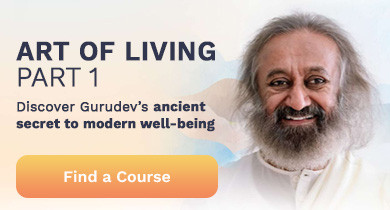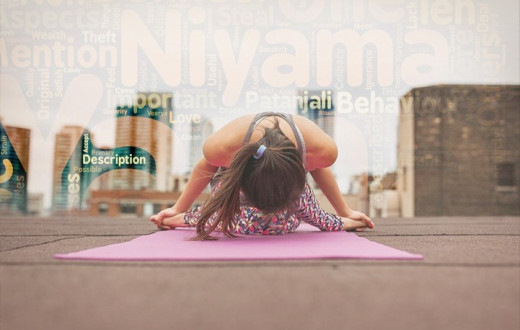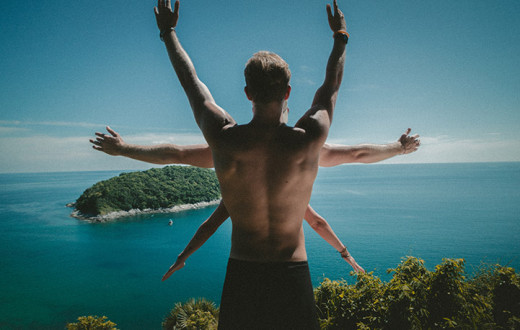By Elizabeth Herman┃Posted: May 31, 2019
Besides the physical postures, when do you practice yoga? The type of yoga that you practice in many situations, through all of your actions in the world, is called Karma Yoga. Outside of your home asana practice or yoga class, in strange and sometimes threatening contexts, the influence of yoga can keep you safe.
For understanding how Karma Yoga works to keep you safe anywhere, you might ask, “How can our deeds and thoughts make us safer in situations known to be dangerous? What is the relationship between service and safety?”
Often, we attend yoga sessions, programs and classes where the environment is very safe and feels that way. Or, we may not really know whether or not we’re safe there, but we don’t question that some universal divine power will support us.
But what happens when we have to use the principles of yoga in places that aren’t so well protected? When we work or go to school where not everyone embraces peaceful ways of living, how can we use Karma Yoga to create peace right then and there?
A recent experience at a school in the USA
As a substitute teacher, I have worked in many classrooms at different levels. Occasionally, students will talk about the current prevalence of school shootings, and how they and their schools deal with the possibility of such a tragic and horrifying event happening to them.
In one pre-K classroom, there was a 3 year old child (I’ll call him Jimmy) who had a hard time paying attention during story time. He sometimes started to pretend that he was holding a gun and pointing it at other children. That behavior was one of many that were deemed unacceptable by the school’s principal.
Especially during afternoon nap time, he couldn’t keep still and quiet, nor show respect for other students’ needs for quiet time on their own. He would roll around the floor like a worm rather than stay on his cot.
The teacher had me physically block Jimmy from leaving his corner between the assistant teacher’s desk and a shelving unit for books and toys. We used a small gate to block that corner off, and still he crawled under the desk to get out. He also started throwing things at one of the barriers, and I put a soft mat to cushion the sound of his throwing and hitting of toys.
What makes you feel safe?
At one point, I was sitting with little Jimmy in that corner, whispering to him that he should quiet down during nap time. He told me that his family owns guns and keeps them in the house, because it makes them feel safe.
He asked me if I owned a gun. I said, “No.”
With a deep in-breath of amazement and shock, as though he thought everyone had a gun, he asked me, “What do you do to feel safe without a gun?”
I said, “I help people, and helping other people makes me feel safe.”
He looked at me with a wide-eyed, shocked expression, asked me how that could be, and when I stuck to my same answer, he expressed his amazed surprise, and then quickly let the subject drop. I repeated my answer a few times with a confident smile, hoping it would make Jimmy think about his concept of how relationships with others work.
How helping others protects our safety
Helping others for safety’s sake is the only answer that makes sense to me. The willingness to reach out and help has a unique way of disarming people and surprising them with the kindness of both strangers and familiar faces. It makes them less likely to react angrily and violently.
Teaching the value of safety through service would go a long way towards doing away with the idea that weapons of war are the only viable form of protection.
Here are some steps you can take to feel safer in the world today without weapons:
Become proactive by making service to others a regular part of your routine.
Tell someone in charge (local police, FBI, teacher, counselor, boss, or government aide) if you sense a person is angry and might commit a violent act.
Embrace a peaceful, non-violent lifestyle by learning many healthy ways to respond instead of reacting negatively to others.
Face up to any inner fears and anger issues you may be carrying around, and find ways to resolve them.
Practice acceptance and a smile if someone blames you or tries to start a conflict. Ignore them if they continue to try to provoke anger or fear in you.
Approach others with love, including strangers. Don’t engage in pointless arguments.
Creating a divine society
The Art of Living Foundation in India offers a course called DSN (Divya Samaj Ka Nirman or creating a divine society) that emphasizes individual and collective empowerment through service to others.
In the USA, we have the Youth Empowerment Seminar (YES) and other courses for young people (Art Excel, Angels, Intuition Process) that will show “future generations that there is enormous strength in non-violence,” as Gurudev Sri Sri Ravi Shankar advocates.
Gurudev Sri Sri Ravi Shankar further states, “With guns, people might gain an individual sense of safety, but perhaps they do not realize what they collectively lose as a society.” As humans learn to relate to one another, the ripple effect of loving behavior should be emphasized for the sake of their own true, ultimate safety.
In other words, as we make others happy and keep helping them generously, we create positive vibrations that expand throughout our immediate surroundings. This wave of happiness itself cradles and protects us from violent thoughts and behaviors that may arise temporarily. It’s a conscious choice that people can make, to create a culture of peace as a shield around them.
The more individuals take on responsibility for creating this protective culture of peace, the more they’ll see that threats and dangers simply fade away when confronted by the power of love in action.
Find or create a peace program for yourself or your child today!
By Elizabeth Herman - PhD in English, with concentrations in Rhetoric and Composition, and Literature, she offers writing support to clients, teaches locally, lives in Boone, NC, and volunteers for a better world.





























